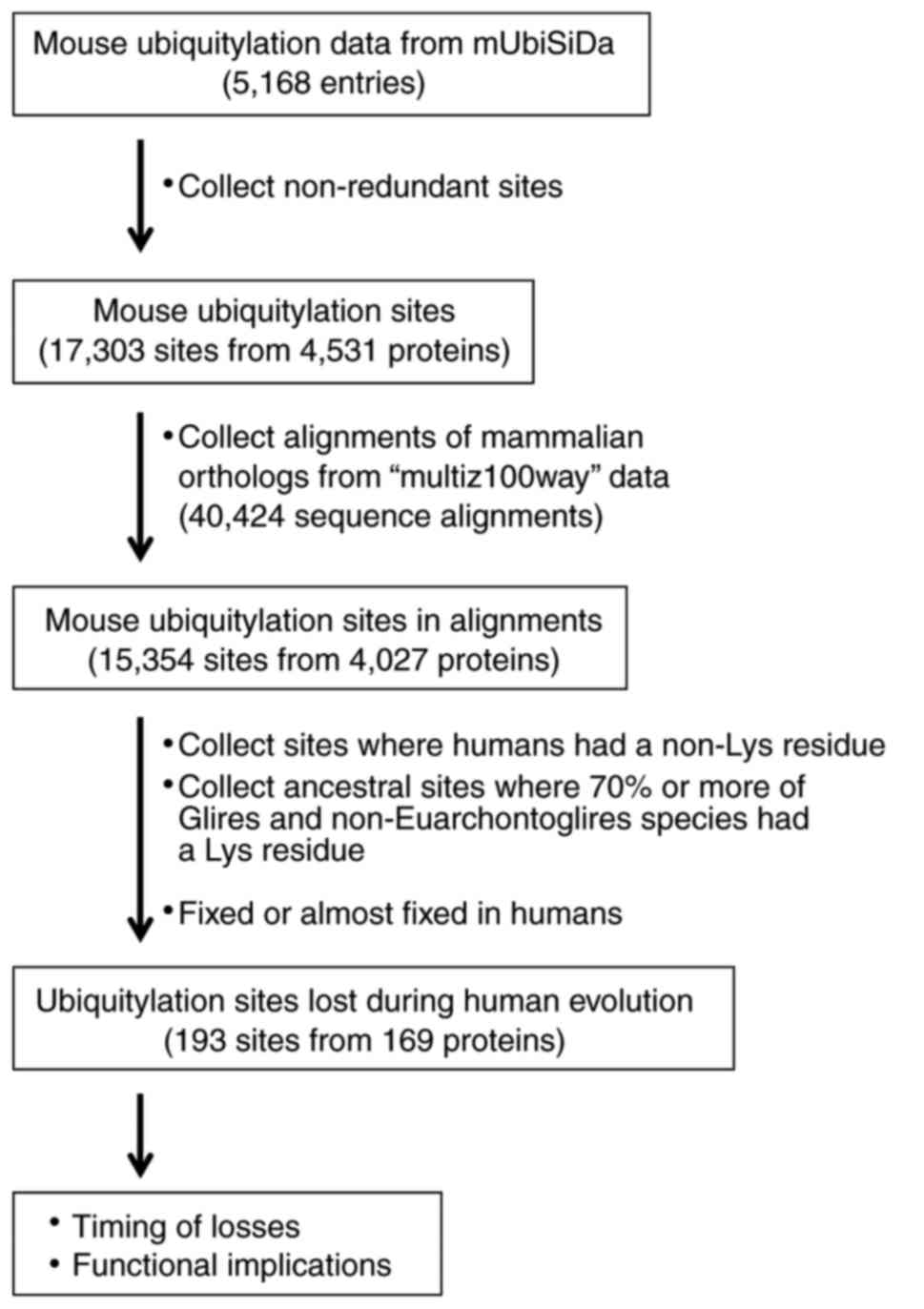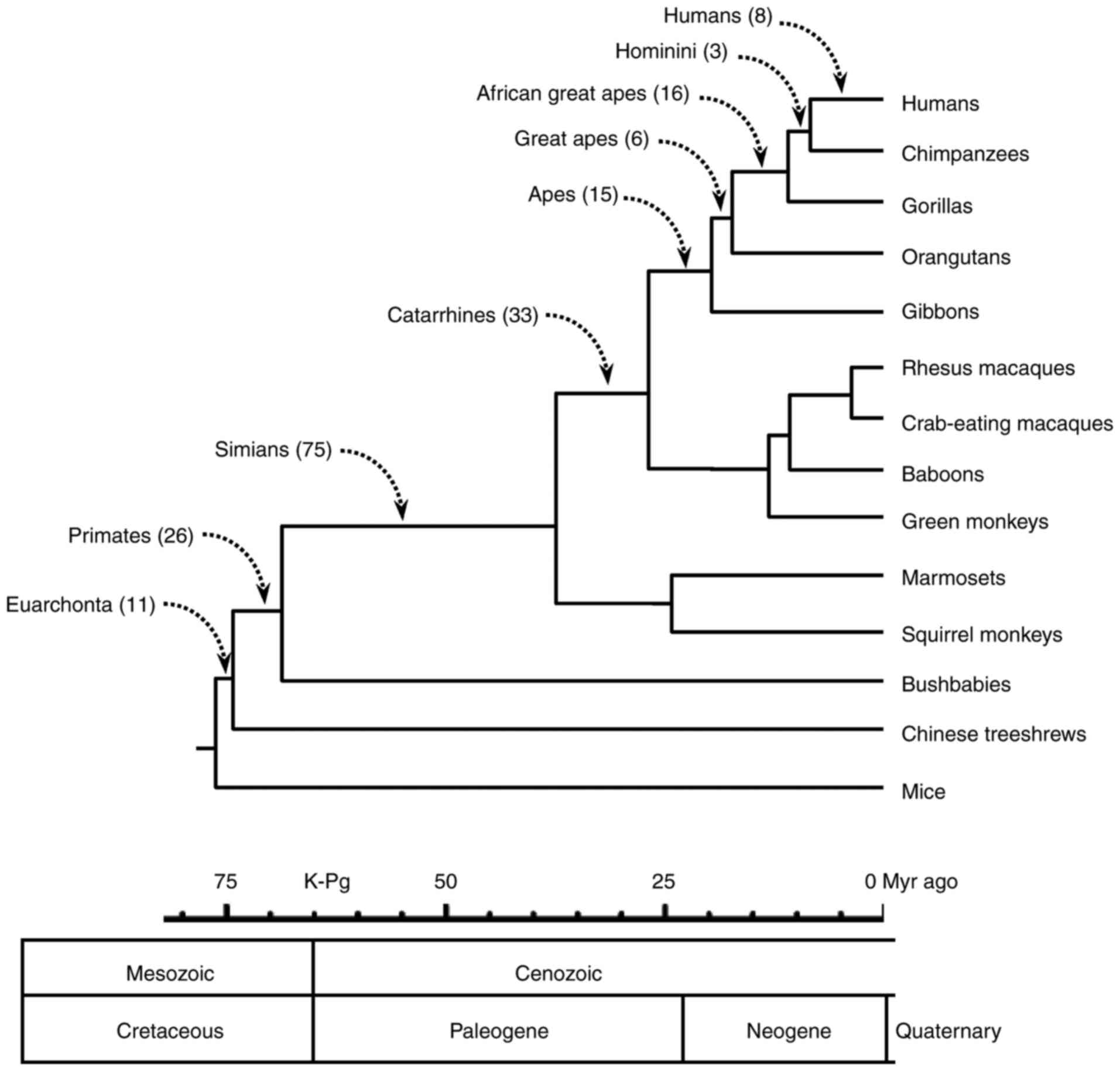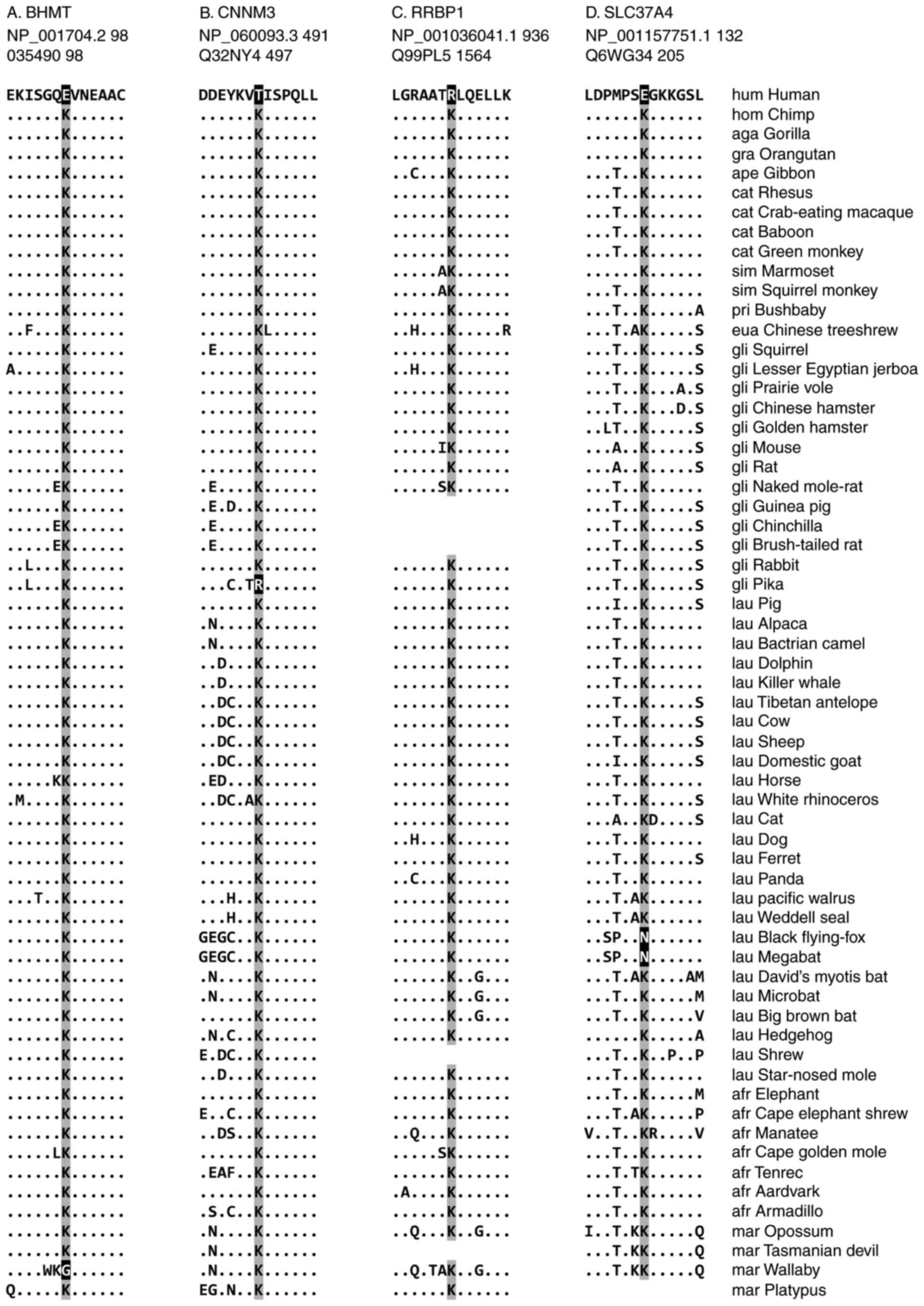|
1
|
Kerscher O, Felberbaum R and Hochstrasser
M: Modification of proteins by ubiquitin and ubiquitin-like
proteins. Annu Rev Cell Dev Biol. 22:159–180. 2006. View Article : Google Scholar : PubMed/NCBI
|
|
2
|
Komander D and Rape M: The ubiquitin code.
Annu Rev Biochem. 81:203–229. 2012. View Article : Google Scholar : PubMed/NCBI
|
|
3
|
Swatek KN and Komander D: Ubiquitin
modifications. Cell Res. 26:399–422. 2016. View Article : Google Scholar : PubMed/NCBI
|
|
4
|
Kwon YT and Ciechanover A: The ubiquitin
code in the ubiquitin-proteasome system and autophagy. Trends
Biochem Sci. 42:873–886. 2017. View Article : Google Scholar : PubMed/NCBI
|
|
5
|
Konstantinova IM, Tsimokha AS and
Mittenberg AG: Role of proteasomes in cellular regulation. Int Rev
Cell Mol Biol. 267:59–124. 2008. View Article : Google Scholar : PubMed/NCBI
|
|
6
|
Preston GM and Brodsky JL: The evolving
role of ubiquitin modification in endoplasmic reticulum-associated
degradation. Biochem J. 474:445–469. 2017. View Article : Google Scholar : PubMed/NCBI
|
|
7
|
Popovic D, Vucic D and Dikic I:
Ubiquitination in disease pathogenesis and treatment. Nat Med.
20:1242–1253. 2014. View
Article : Google Scholar : PubMed/NCBI
|
|
8
|
Stojkovic K, Wing SS and Cermakian N: A
central role for ubiquitination within a circadian clock protein
modification code. Front Mol Neurosci. 7:692014. View Article : Google Scholar : PubMed/NCBI
|
|
9
|
Kim W, Bennett EJ, Huttlin EL, Guo A, Li
J, Possemato A, Sowa ME, Rad R, Rush J, Comb MJ, et al: Systematic
and quantitative assessment of the ubiquitin-modified proteome. Mol
Cell. 44:325–340. 2011. View Article : Google Scholar : PubMed/NCBI
|
|
10
|
Wagner SA, Beli P, Weinert BT, Nielsen ML,
Cox J, Mann M and Choudhary C: A proteome-wide, quantitative survey
of in vivo ubiquitylation sites reveals widespread regulatory
roles. Mol Cell Proteomics. 10:M1110132842011. View Article : Google Scholar
|
|
11
|
Caron C, Boyault C and Khochbin S:
Regulatory cross-talk between lysine acetylation and
ubiquitination: Role in the control of protein stability.
BioEssays. 27:408–415. 2005. View Article : Google Scholar : PubMed/NCBI
|
|
12
|
Hunter T: The age of crosstalk:
Phosphorylation, ubiquitination, and beyond. Mol Cell. 28:730–738.
2007. View Article : Google Scholar : PubMed/NCBI
|
|
13
|
Chen ZJ: Ubiquitin signalling in the
NF-kappaB pathway. Nat Cell Biol. 7:758–765. 2005. View Article : Google Scholar : PubMed/NCBI
|
|
14
|
Al-Hakim AK, Zagorska A, Chapman L, Deak
M, Peggie M and Alessi DR: Control of AMPK-related kinases by USP9X
and atypical Lys(29)/Lys(33)-linked polyubiquitin chains. Biochem
J. 411:249–260. 2008. View Article : Google Scholar : PubMed/NCBI
|
|
15
|
Li WH and Saunders MA: News and views: The
chimpanzee and us. Nature. 437:50–51. 2005. View Article : Google Scholar : PubMed/NCBI
|
|
16
|
Varki A and Altheide TK: Comparing the
human and chimpanzee genomes: Searching for needles in a haystack.
Genome Res. 15:1746–1758. 2005. View Article : Google Scholar : PubMed/NCBI
|
|
17
|
Ruiz-Orera J, Hernandez-Rodriguez J, Chiva
C, Sabidó E, Kondova I, Bontrop R, Marqués-Bonet T and Albà MM:
Origins of de novo genes in human and chimpanzee. PLoS Genet.
11:e10057212015. View Article : Google Scholar
|
|
18
|
Kim DS and Hahn Y: Identification of
human-specific transcript variants induced by DNA insertions in the
human genome. Bioinformatics. 27:14–21. 2011. View Article : Google Scholar
|
|
19
|
Hahn Y, Jeong S and Lee B: Inactivation of
MOXD2 and S100A15A by exon deletion during human evolution. Mol
Biol Evol. 24:2203–2212. 2007. View Article : Google Scholar : PubMed/NCBI
|
|
20
|
Zhu J, Sanborn JZ, Diekhans M, Lowe CB,
Pringle TH and Haussler D: Comparative genomics search for losses
of long-established genes on the human lineage. PLoS Comput Biol.
3:e2472007. View Article : Google Scholar : PubMed/NCBI
|
|
21
|
Oh HJ, Choi D, Goh CJ and Hahn Y: Loss of
gene function and evolution of human phenotypes. BMB Rep.
48:373–379. 2015. View Article : Google Scholar : PubMed/NCBI
|
|
22
|
Lynch VJ, May G and Wagner GP: Regulatory
evolution through divergence of a phosphoswitch in the
transcription factor CEBPB. Nature. 480:383–386. 2011. View Article : Google Scholar : PubMed/NCBI
|
|
23
|
Kim DS and Hahn Y: Identification of novel
phosphorylation modification sites in human proteins that
originated after the human-chimpanzee divergence. Bioinformatics.
27:2494–2501. 2011. View Article : Google Scholar : PubMed/NCBI
|
|
24
|
Kim DS and Hahn Y: Gains of ubiquitylation
sites in highly conserved proteins in the human lineage. BMC
Bioinformatics. 13:3062012. View Article : Google Scholar : PubMed/NCBI
|
|
25
|
Kim DS and Hahn Y: The acquisition of
novel N-glycosylation sites in conserved proteins during human
evolution. BMC Bioinformatics. 16:292015. View Article : Google Scholar : PubMed/NCBI
|
|
26
|
Kim DS, Choi D and Hahn Y: Loss of
ancestral N-glycosylation sites in conserved proteins during human
evolution. Int J Mol Med. 36:1685–1692. 2015. View Article : Google Scholar : PubMed/NCBI
|
|
27
|
Chen T, Zhou T, He B, Yu H, Guo X, Song X
and Sha J: mUbi-SiDa: A comprehensive database for protein
ubiquitination sites in mammals. PLoS One. 9:e857442014. View Article : Google Scholar
|
|
28
|
Rosenbloom KR, Armstrong J, Barber GP,
Casper J, Clawson H, Diekhans M, Dreszer TR, Fujita PA, Guruvadoo
L, Haeussler M, et al: The UCSC genome browser database: 2015
update. Nucleic Acids Res. 43:D670–D681. 2015. View Article : Google Scholar :
|
|
29
|
Blanchette M, Kent WJ, Riemer C, Elnitski
L, Smit AF, Roskin KM, Baertsch R, Rosenbloom K, Clawson H, Green
ED, et al: Aligning multiple genomic sequences with the threaded
blockset aligner. Genome Res. 14:708–715. 2004. View Article : Google Scholar : PubMed/NCBI
|
|
30
|
Park J, Chen Y, Tishkoff DX, Peng C, Tan
M, Dai L, Xie Z, Zhang Y, Zwaans BM, Skinner ME, et al:
SIRT5-mediated lysine desuccinylation impacts diverse metabolic
pathways. Mol Cell. 50:919–930. 2013. View Article : Google Scholar : PubMed/NCBI
|
|
31
|
Finkelstein JD, Harris BJ and Kyle WE:
Methionine metabolism in mammals: Kinetic study of
betaine-homocysteine methyl-transferase. Arch Biochem Biophys.
153:320–324. 1972. View Article : Google Scholar : PubMed/NCBI
|
|
32
|
Garrow TA: Purification, kinetic
properties, and cDNA cloning of mammalian betaine-homocysteine
methyltransferase. J Biol Chem. 271:22831–22838. 1996. View Article : Google Scholar : PubMed/NCBI
|
|
33
|
Lee MB, Kooistra M, Zhang B, Slow S,
Fortier AL, Garrow TA, Lever M, Trasler JM and Baltz JM: Betaine
homocysteine meth-yltransferase is active in the mouse blastocyst
and promotes inner cell mass development. J Biol Chem.
287:33094–33103. 2012. View Article : Google Scholar : PubMed/NCBI
|
|
34
|
Prieur EAK, Pjetri E, Zeisel SH and
Jadavji NM: Reduced brain volume and impaired memory in betaine
homocysteine S-methyltransferase knockout mice. Appl Physiol Nutr
Metab. 42:1228–1231. 2017. View Article : Google Scholar : PubMed/NCBI
|
|
35
|
Islam Z, Hayashi N, Inoue H, Umezawa T,
Kimura Y, Doi H, Romero MF, Hirose S and Kato A: Identification and
lateral membrane localization of cyclin M3, likely to be involved
in renal Mg2+ handling in seawater fish. Am J Physiol
Regul Integr Comp Physiol. 307:R525–R537. 2014. View Article : Google Scholar : PubMed/NCBI
|
|
36
|
Gulerez I, Funato Y, Wu H, Yang M, Kozlov
G, Miki H and Gehring K: Phosphocysteine in the PRL-CNNM pathway
mediates magnesium homeostasis. EMBO Rep. 17:1890–1900. 2016.
View Article : Google Scholar : PubMed/NCBI
|
|
37
|
Zhang H, Kozlov G, Li X, Wu H, Gulerez I
and Gehring K: PRL3 phosphatase active site is required for binding
the putative magnesium transporter CNNM3. Sci Rep. 7:482017.
View Article : Google Scholar : PubMed/NCBI
|
|
38
|
Hardy S, Uetani N, Wong N, Kostantin E,
Labbé DP, Bégin LR, Mes-Masson A, Miranda-Saavedra D and Tremblay
ML: The protein tyrosine phosphatase PRL-2 interacts with the
magnesium transporter CNNM3 to promote oncogenesis. Oncogene.
34:986–995. 2015. View Article : Google Scholar
|
|
39
|
Kostantin E, Hardy S, Valinsky WC,
Kompatscher A, de Baaij JH, Zolotarov Y, Landry M, Uetani N,
Martínez-Cruz LA, Hoenderop JG, et al: Inhibition of PRL-2-CNNM3
protein complex formation decreases breast cancer proliferation and
tumor growth. J Biol Chem. 291:10716–10725. 2016. View Article : Google Scholar : PubMed/NCBI
|
|
40
|
Savitz AJ and Meyer DI: Identification of
a ribosome receptor in the rough endoplasmic reticulum. Nature.
346:540–544. 1990. View Article : Google Scholar : PubMed/NCBI
|
|
41
|
Tsai HY, Yang YF, Wu AT, Yang CJ, Liu YP,
Jan YH, Lee CH, Hsiao YW, Yeh CT, Shen CN, et al: Endoplasmic
reticulum ribo-some-binding protein 1 (RRBP1) overexpression is
frequently found in lung cancer patients and alleviates
intracellular stress-induced apoptosis through the enhancement of
GRP78. Oncogene. 32:4921–4931. 2013. View Article : Google Scholar : PubMed/NCBI
|
|
42
|
Hyde M, Block-Alper L, Felix J, Webster P
and Meyer DI: Induction of secretory pathway components in yeast is
associated with increased stability of their mRNA. J Cell Biol.
156:993–1001. 2002. View Article : Google Scholar : PubMed/NCBI
|
|
43
|
Telikicherla D, Marimuthu A, Kashyap MK,
Ramachandra YL, Mohan S, Roa JC, Maharudraiah J and Pandey A:
Overexpression of ribosome binding protein 1 (RRBP1) in breast
cancer. Clin Proteomics. 9:72012. View Article : Google Scholar : PubMed/NCBI
|
|
44
|
Liang X, Sun S, Zhang X, Wu H, Tao W, Liu
T, Wei W, Geng J and Pang D: Expression of ribosome-binding protein
1 correlates with shorter survival in Her-2 positive breast cancer.
Cancer Sci. 106:740–746. 2015. View Article : Google Scholar : PubMed/NCBI
|
|
45
|
Pan Y, Cao F, Guo A, Chang W, Chen X, Ma
W, Gao X, Guo S, Fu C and Zhu J: Endoplasmic reticulum
ribosome-binding protein 1, RRBP1, promotes progression of
colorectal cancer and predicts an unfavourable prognosis. Br J
Cancer. 113:763–772. 2015. View Article : Google Scholar : PubMed/NCBI
|
|
46
|
Gerin I, Veiga-da-Cunha M, Achouri Y,
Collet JF and Van Schaftingen E: Sequence of a putative glucose
6-phosphate translocase, mutated in glycogen storage disease type
Ib. FEBS Lett. 419:235–238. 1997. View Article : Google Scholar
|
|
47
|
Veiga-da-Cunha M, Gerin I, Chen YT, de
Barsy T, de Lonlay P, Dionisi-Vici C, Fenske CD, Lee PJ, Leonard
JV, Maire I, et al: A gene on chromosome 11q23 coding for a
putative glucose- 6-phosphate translocase is mutated in
glycogen-storage disease types Ib and Ic. Am J Hum Genet.
63:976–983. 1998. View
Article : Google Scholar : PubMed/NCBI
|
|
48
|
Chou JY and Mansfield BC: The SLC37 family
of sugar-phosphate/phosphate exchangers. Curr Top Membr.
73:357–382. 2014. View Article : Google Scholar : PubMed/NCBI
|
|
49
|
Ahn HH, Oh Y, Lee H, Lee W, Chang JW, Pyo
HK, Nah do H and Jung YK: Identification of glucose-6-phosphate
transporter as a key regulator functioning at the autophagy
initiation step. FEBS Lett. 589:2100–2109. 2015. View Article : Google Scholar : PubMed/NCBI
|
|
50
|
Azevedo C and Saiardi A: Why always
lysine? The ongoing tale of one of the most modified amino acids.
Adv Biol Regul. 60:144–150. 2016. View Article : Google Scholar
|
|
51
|
Hagai T, Toth-Petroczy A, Azia A and Levy
Y: The origins and evolution of ubiquitination sites. Mol Biosyst.
8:1865–1877. 2012. View Article : Google Scholar : PubMed/NCBI
|
|
52
|
Moses AM, Liku ME, Li JJ and Durbin R:
Regulatory evolution in proteins by turnover and lineage-specific
changes of cyclin-dependent kinase consensus sites. Proc Natl Acad
Sci USA. 104:17713–17718. 2007. View Article : Google Scholar : PubMed/NCBI
|
|
53
|
Gulzar N, Dingerdissen H, Yan C and
Mazumder R: Impact of nonsynonymous single-nucleotide variations on
post-translational modification sites in human proteins. Methods
Mol Biol. 1558:159–190. 2017. View Article : Google Scholar : PubMed/NCBI
|
|
54
|
Lu L, Li Y, Liu Z, Liang F, Guo F, Yang S,
Wang D, He Y, Xiong J, Li D and He F: Functional constraints on
adaptive evolution of protein ubiquitination sites. Sci Rep.
7:399492017. View Article : Google Scholar : PubMed/NCBI
|
|
55
|
Lehmann AR: DNA repair-deficient diseases,
xeroderma pigmentosum, Cockayne syndrome and trichothiodystrophy.
Biochimie. 85:1101–1111. 2003. View Article : Google Scholar
|
|
56
|
Hu H and Sun SC: Ubiquitin signaling in
immune responses. Cell Res. 26:457–483. 2016. View Article : Google Scholar : PubMed/NCBI
|
|
57
|
Zohaib A, Duan X, Zhu B, Ye J, Wan S, Chen
H, Liu X and Cao S: The role of ubiquitination in regulation of
innate immune signaling. Curr Issues Mol Biol. 18:1–10. 2016.
|
|
58
|
Liu X, Wang Q, Chen W and Wang C: Dynamic
regulation of innate immunity by ubiquitin and ubiquitin-like
proteins. Cytokine Growth Factor Rev. 24:559–570. 2013. View Article : Google Scholar : PubMed/NCBI
|
|
59
|
Chakraborty J, Basso V and Ziviani E: Post
translational modification of Parkin. Biol Direct. 12:62017.
View Article : Google Scholar : PubMed/NCBI
|
|
60
|
Fulda S, Rajalingam K and Dikic I:
Ubiquitylation in immune disorders and cancer: From molecular
mechanisms to therapeutic implications. EMBO Mol Med. 4:545–556.
2012. View Article : Google Scholar : PubMed/NCBI
|
|
61
|
Narayan S, Bader GD and Reimand J:
Frequent mutations in acetylation and ubiquitination sites suggest
novel driver mechanisms of cancer. Genome Med. 8:552016. View Article : Google Scholar : PubMed/NCBI
|
|
62
|
Ortega Z and Lucas JJ:
Ubiquitin-proteasome system involvement in Huntington’s disease.
Front Mol Neurosci. 7:772014. View Article : Google Scholar
|
|
63
|
McClurg UL, Cork DMW, Darby S, Ryan-Munden
CA, Nakjang S, Mendes Côrtes L, Treumann A, Gaughan L and Robson
CN: Identification of a novel K311 ubiquitination site critical for
androgen receptor transcriptional activity. Nucleic Acids Res.
45:1793–1804. 2017. View Article : Google Scholar :
|
|
64
|
Bonacci T, Audebert S, Camoin L, Baudelet
E, Iovanna JL and Soubeyran P: Regulation of NUB1 activity through
non-proteolytic Mdm2-mediated ubiquitination. PLoS One.
12:e01699882017. View Article : Google Scholar : PubMed/NCBI
|
|
65
|
Glorian V, Allègre J, Berthelet J,
Dumetier B, Boutanquoi PM, Droin N, Kayaci C, Cartier J, Gemble S,
Marcion G, et al: DNA damage and S phase-dependent E2F1
stabilization requires the cIAP1 E3-ubiquitin ligase and is
associated with K63-poly-ubiquitination on lysine 161/164 residues.
Cell Death Dis. 8:e28162017. View Article : Google Scholar : PubMed/NCBI
|
|
66
|
Tessadori F, Giltay JC, Hurst JA, Massink
MP, Duran K, Vos HR, van Es RM; Deciphering Developmental Disorders
Study; Scott RH, van Gassen KLI, et al: Germline mutations
affecting the histone H4 core cause a developmental syndrome by
altering DNA damage response and cell cycle control. Nat Genet.
49:1642–1646. 2017. View Article : Google Scholar : PubMed/NCBI
|
|
67
|
Kim OJ: A single mutation at lysine 241
alters expression and trafficking of the D2 dopamine receptor. J
Recept Signal Transduct Res. 28:453–464. 2008. View Article : Google Scholar : PubMed/NCBI
|












